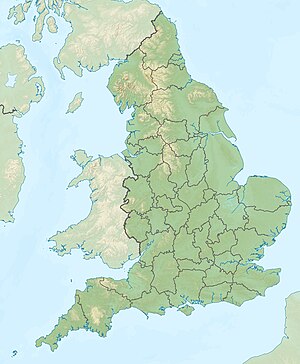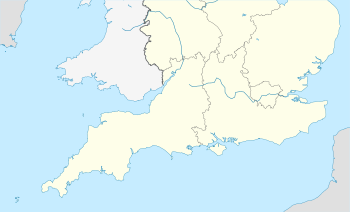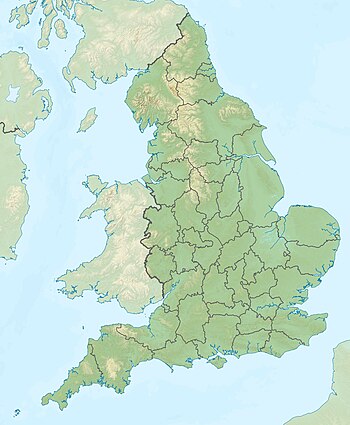First English Civil War
| First English Civil War | |||||||
|---|---|---|---|---|---|---|---|
| Part ofWars of the Three Kingdoms | |||||||
 The Battle of Marston Moor 1644,by James Barker | |||||||
| |||||||
| Belligerents | |||||||
|
| |||||||
| Commanders and leaders | |||||||
| Casualties and losses | |||||||
| 1642–1646 | 1642–1646 | ||||||
TheFirst English Civil Wartook place inEnglandandWalesfrom 1642 to 1646, and forms part of the 1639 to 1653Wars of the Three Kingdoms.[a]An estimated 15% to 20% of adult males in England and Wales served in the military at some point between 1639 and 1653, while around 4% of the total population died from war-related causes.[b]These figures illustrate the widespread impact of the conflict on society, and the bitterness it engendered as a result.[2]
Conflict over the role ofParliamentand religious practice dated from the accession ofJames VI and Iin 1603. These tensions culminated in the imposition ofPersonal Rulein 1629 by his son,Charles I,who recalled Parliament inAprilandNovember1640. He hoped by doing so to obtain funding that would enable him to reverse his defeat by ScotsCovenantersin the Bishops' Wars, but in return Parliament demanded a greater share in government than he was willing to concede.
In its early stages, the vast majority on both sides supported the institution of monarchy, but disagreed on who held ultimate authority.Royalistsgenerally argued both Parliament and theChurch of Englandwere subordinate to the king, while most of theirParliamentarianopponents claimed his supremacy did not extend to religion, and wanted a form ofconstitutional monarchy.When it came to choosing sides, however, individual choices were heavily influenced by religious belief or personal loyalty. Horrified at the devastation inflicted onEuropeby theThirty Years War,many tried to remain neutral, or took up arms with great reluctance.
When fighting began in August 1642, both sides believed it would be settled by a single battle, but it soon became clear this was not the case. Royalist successes in 1643 led to analliancebetween Parliament and the Scots, who won a series of battles in 1644, the most significant being theBattle of Marston Moor.Alleged failures to exploit these successes led Parliament in February 1645 to set up theNew Model Army,the first centrally-funded and professional military force in England, whose success atNasebyin June 1645 proved decisive. The war ended with victory for the Parliamentarian alliance in June 1646 and Charles in custody. However, his refusal to agree concessions, combined with divisions among his opponents, led to theSecond English Civil Warin 1648, followed by hisexecutionin January 1649.
Overview[edit]
The 1642 to 1646 First English Civil War is one of a series ofcivil warsfought between 1639 and 1653 inEnglandandWales,along with the separate kingdoms ofScotlandandIreland.[c]Known collectively as theWars of the Three Kingdoms,others include the 1639 and 1640Bishops' Wars,1641 to 1653Irish Confederate Wars,1648Second English Civil War,1649 to 1653Cromwellian conquest of Ireland,and 1650 to 1652Anglo-Scottish War,previously known as the Third English Civil War.[3]The First and Second English Civil Wars are sometimes grouped together as the 1642 to 1648English Civil War.[4]
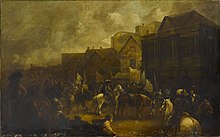
The underlying cause of the war in England was a long-running struggle for political and religious control between the monarchy andParliamentthat began whenJames VI and Ibecame king in 1603. The issues arising re-surfaced after the 1660Stuart Restoration,and were arguably only resolved by the 1688Glorious Revolution.American historians likeKevin Phillipshave identified many similarities between the principles at stake in 1642, and those which led to theAmerican Revolutionin 1776.[5]
Royalist or Parliamentarian[edit]
A simple division of the opposing parties into RoyalistCavaliersand ParliamentarianRoundheadsis a perspective that is now accepted as outdated, but which still informs modern perceptions.[6]These are also influenced by the complex historical reputation ofOliver Cromwell,particularly inIreland.The installation of hisstatueoutside theHouses of Parliamentwas approved in 1856, but not carried out until 1895, with most of the funds supplied by Prime MinisterLord Rosebery.In 2004, a group ofMPsunsuccessfully proposed amotionto have it melted down, and the debate continues.[7]
However, individual motives for choosing a side were complex, and there were wide areas of alignment between Royalists and Parliamentarians. Many tried to remain neutral, or participated with extreme reluctance, while others fought on both sides at different points. HistorianTim Harrissuggests that by 1640, most agreedattempts by Charles to govern without Parliamenthad gone too far. After theGrand Remonstrancewas submitted in late 1641, moderates likeEdward Hydecreated a Royalist political faction, arguingParliamentwas trying to alter the balance too much the other way.[8]

Both sides claimed they were seeking to restore the "ancient constitution". For many supporters of Parliament,Stuartconcepts of thedivine right of kingsandabsolutismbrought in byJames VI and Iin 1603 were "innovations" that had undermined "traditional" English freedoms and rights. However, there were different views on the nature of these "rights". This caused divisions within Parliament as the war progressed, since not everyone agreed on what they were seeking to restore, or even if it were desirable.[9]
Most Parliamentarians went to war in 1642 not to depose the king but regulate his powers, while only a tiny minority sought to abolish the monarchy altogether.John Pym,Parliamentarian leader in theCommons,was one of the few who believed forcing Charles to abdicate might be the only option, since past experience showed he would not keep commitments he considered forced on him. Examples included his annulment of the 1628Petition of Right,and the recentBishops Wars,when he agreedpeace termswith the Scots in 1639 only to provide time to plan another military campaign in 1640. These doubts were confirmed when he and his wifeHenrietta Mariarepeatedly told foreign ambassadors any concessions made to Parliament were temporary, and would be retrieved by force.[10]
Charles' credibility mattered because regardless of religion or political belief, the vast majority in all three kingdoms believed a 'well-ordered' monarchy was divinely mandated. His opponents argued that if Charles would not obey his own laws or keep his promises, this presented a threat to the state which required either forcing him to do so, or deposing him in favour of his eldest son. Where they disagreed was what 'well-ordered' meant, particularly in terms of the role of Parliament, and control of the church. Both issues were linked, because in the 17th century 'true religion' and 'good government' were seen as mutually dependent. In general,Royalistssupported aChurch of Englandgoverned bybishops,appointed by, and answerable to, the king, while mostParliamentariansbelieved he was answerable to the leaders of the church, appointed by their congregations.[11]
Another common misperception is that "Roundhead" was interchangeable with "Puritan".In reality, this term applied to anyone who wanted to" purify "the Church of England of" Papist "practices, and covered a wide range of views.[12]Although the majority supported Parliament, some prominent Puritans likeSir William Savilebacked Charles out of personal loyalty.[13]Conversely, many Royalists objected toLaudianism,and opposed the appointment ofCatholicsto senior positions, while attempts to integrate Irish Catholic troops in 1643 caused some regiments to mutiny.[14]Parliamentarians were divided betweenPresbyterianslike Pym who wanted to reform the Church of England, and religiousIndependentswho rejected any form ofestablished churchand wanted it abolished. They includedCongregationalistslike Cromwell andBaptists,who were especially well represented in theNew Model Army.[15]

Later in the war, conflicting religious and political aims resulted in the emergence within Parliament of a middle party of "Independent Royalists". These were generally religious radicals but social conservatives, led byWilliam Fiennes, 1st Viscount Saye and Sele,his sonNathaniel Fiennes,andNathaniel Rich.They were distinguished from Royalists in believing Charles had to be defeated militarily, and from moderate Presbyterians by their fervent opposition to state-mandated religion. After Parliament's victory in 1646, this group supported theTreaty of Newport,and a "balanced" political solution that would leave Charles on the throne. Its members avoided participation in histrialandexecution,although they did not speak against it.[16]
While Puritans were the most visible in opposing Laudian reforms and demanding the removal ofbishopsfrom the Church of England, their objections were shared by many Royalists, such asGeorge Morleyand SirEdmund Verney.[d][17]One reason was that bishops held a variety of non-religious roles which impacted all levels of society; they acted as state censors, who were able to ban sermons and writings, while ordinary people could be tried bychurch courtsfor crimes includingblasphemy,heresy,fornicationand other 'sins of the flesh', as well as matrimonial or inheritance disputes.[18]As members of theHouse of Lords,bishops often blocked legislation opposed by the Crown; their ousting from Parliament by theClergy Act 1640was a major step on the road to war, since it meant Charles could no longer prevent passage of legislation that he opposed.[19]
Their removal temporarily ended censorship, and especially in London led to an explosion in the printing of pamphlets, books and sermons, many advocating radical religious and political ideas.[20]Even before 1642, such radicalism concerned conservative Parliamentarians likeDenzil Holles.As the war progressed, both they and their Scottish Covenanter allies came to see the Independents and New Model Army as more dangerous than the Royalists and formed the "Peace Party", seeking a negotiated end to the fighting. An alliance between Royalists and these two groups led to theSecond English Civil Warin 1648.[21]
Lastly, in 1642 England and Wales were part of a highly structured, socially conservative and peaceful society, while the devastation caused by theThirty Years WarinEuropemeant many wanted to avoid conflict at any cost. Choice of sides was often driven by personal relationships or loyalties, and in the early stages there were numerous examples of armed neutrality, or local truces, designed to force the two sides to negotiate.[22]
1642[edit]
Over the winter of 1641 to 1642, many towns strengthened their defences, and purchased weapons, although not necessarily due to fears of civil war. Lurid details of theIrish Rebellion of 1641meant many were more concerned by reports of a plannedCatholicinvasion.[23]Both sides supported raising troops to suppress the rising, but allegedRoyalist conspiraciesto use them against Parliament meant neither trusted the other with their control. When Charles left London after failing to arrest theFive Membersin January 1642, he handed Parliament control of the largest city, port and commercial centre in England, its biggest weapons store in theTower of London,and best equipped local militia, ortrained bands.[24]
Founded in 1572, these were organised bycounty,controlled bylord-lieutenantsappointed by the king, and constituted the only permanent military force in the country. The muster roll of February 1638 shows wide variations in size, equipment and training;Yorkshirehad the largest, with 12,000 men, followed by London with 8,000, later increased to 20,000. 'Royalist' counties likeShropshireorGlamorganhad fewer than 500 men.[25]
In March 1642, Parliament approved theMilitia Ordinance,claiming control of the trained bands; Charles responded with his ownCommissions of Array.More important than the men were the localarsenals,with Parliament holding the two largest in London, andHull.These belonged to the local community, who often resisted attempts to remove them, by either side. In RoyalistCheshire,the towns ofNantwich,KnutsfordandChesterdeclared a state of armed neutrality, and excluded both parties.[26]
Ports were vital for access to internal and external waterways, the primary method of importing and transporting bulk supplies until the advent of railways in the 19th century. Most of theRoyal Navydeclared for Parliament, allowing them to protect the trade routes vital to the London merchant community, block Royalist imports and resupply isolated Parliamentarian garrisons. It also made other countries wary of antagonising one of the strongest navies in Europe by providing support to their opponents.[27]By September, forces loyal to Parliament held every major port in England apart fromNewcastle,which prevented Royalist areas inWalesandSouth WestandNorth EastEngland from supporting each other. In February 1642, Charles sent his wife,Henrietta Maria,tothe Hagueto raise money and purchase weapons; lack of a secure port delayed her return until February 1643, and even then, she narrowly escaped capture.[28]
On 1 June 1642, Parliament approved a list of proposals known as theNineteen Propositions,which would give them control over ministerial appointments, the army and management of the Royal household, including the education and marriage of his children. These were presented to Charles atNewmarket,who angrily rejected them without further discussion.[29]He was later persuaded to issue a more conciliatory answer, whose objective was primarily to appeal to moderates by placing blame for what now seemed an inevitable military conflict on Pym and his followers.[30]Drafted by Hyde, this response has been seen as the origin of "mixed" orconstitutional monarchy,although whether Charles himself genuinely believed in it is debatable.[31]
Both sides expected a single battle and quick victory; for the Royalists, this meant capturing London, for Parliament, 'rescuing' the king from his 'evil counsellors'. After failing tocapture Hullin July, Charles left York forNottingham,chosen for its proximity to Royalist areas in theMidlandsandNorthern Wales.Particularly in the early stages of the conflict, locally raised troops were reluctant to serve outside their own county, and most of those recruited in Yorkshire refused to accompany him.[32]On 22 August, Charles formally declared war on Parliamentarian 'rebels', but by early September his army still numbered less than 2,500, with much of England hoping to remain neutral.[33]
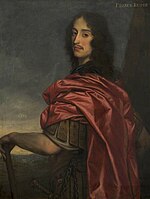
In contrast, financing from the London mercantile community and weapons from the Tower enabled Parliament to recruit and equip an army of 20,000, commanded by the PresbyterianEarl of Essex,who left London on 3 September forNorthampton.[34]Charles relocated toShrewsbury,further away from London but a key Royalist recruitment centre throughout the war. When Essex learned of this, he marched onWorcester,where the first major encounter of the war took place atPowick Bridgeon 23 September. A relatively minor Royalist victory, it established the reputation ofPrince Rupert,whose cavalry gained a psychological edge over their Parliamentarian opponents.[35]
The Royalist army now numbered around 15,000, although much of the infantry were armed with clubs orscythes;while better equipped, the forces of Parliament were half-trained, poorly disciplined, and their logistics inadequate. When Charles headed for London, Essex tried to block his route, and on 23 October, the two armies fought a bloody, chaotic, and indecisive battle atEdgehill.[36]Essex continued retreating towards London; after an inconclusive encounter on 16 November atTurnham Green,west of London, operations ended for the winter. The Royalists withdrew toOxford,which became their capital for the rest of the war. Elsewhere, SirWilliam Wallersecured thesouth-eastfor Parliament; in December,Lord WilmotcapturedMarlborough,opening communications between Oxford, and Royalist forces based atLaunceston, in Cornwall.[37]
1643[edit]
The events of 1642 showed the need to plan for a lengthy conflict. For the Royalists, this meant fortifying their new capital in Oxford, and connecting areas of support in England and Wales; Parliament focused on consolidating control of the areas they already held. Althoughpeace talkswere held, both parties continued to negotiate for Scottish and Irish support. Charles sought to end thewar in Ireland,which would enable him to transfer troops from theRoyal Irish Armyto England.[38]
Fighting continued during the winter in Yorkshire, where the RoyalistDuke of Newcastletried to secure a landing place for an arms shipment from theDutch Republic.With insufficient troops to hold the entire area, his task was further complicated by Parliamentarian forces underLord Fairfaxand his sonThomas,which retained key towns likeHullandLeeds.Along with Henrietta Maria, the weapons convoy finally managed to land atBridlingtonin late February; on 4 June she left York escorted by 5,000 cavalry, arriving in Oxford in mid-July.[39]
In the south-west, Royalist commanderSir Ralph HoptonsecuredCornwallwith victory atBraddock Downin January. In June, he advanced intoWiltshire,inflicting a serious defeat onWaller's'Army of the Southern Association' atRoundway Downon 13 July. Arguably the most comprehensive Royalist victory of the war, it isolated Parliament's garrisons in the west andPrince RupertstormedBristolon 26 July. This gave the Royalists control of the second largest city in Britain and landing point for reinforcements from Ireland.[40]
By late August, the Parliamentarian cause was close to collapse but was saved by Pym's leadership and determination, which resulted in important reforms. Both sides struggled to properly supply troops fighting outside their home regions and Parliament agreed steps to mitigate the problem.[41]Seeing an opportunity to force Parliamentary moderates into a negotiated peace, in September the Royalists agreed a new three-part offensive.[42]Aftertaking Gloucester,Prince Rupert would advance on London, while Newcastle would tie down theEastern Associationarmy by advancing intoEast AngliaandLincolnshire.Finally, Hopton would march intoHampshireandSussex,threatening London from the south, and closing theiron foundriesthat were Parliament's main source of armaments.[43]
However, Essex forced Prince Rupert to retreat from Gloucester, then checked his advance on London atNewburyon 20 September.[44]Although Hopton reachedWinchester,Waller prevented him making further progress; in October, Newcastle abandoned the secondsiege of Hull,while victory atWincebysecured eastern England for Parliament. Royalist failure ended any chance of concluding the war in the near future, leading both sides to step up the search for allies.[45]
In September, theMarquess of Ormond,RoyalistLord Lieutenant of Ireland,agreed a truce with theCatholic Confederation.The "Cessation" meant troops could be sent to England, but it cost Charles the support of many IrishProtestants,especially inMunster.At the same time, details emerged of the "Antrim scheme", an alleged plan to use 20,000 Irish troops to recapture southernScotlandfor Charles. Although highly impractical, theCovenantergovernment now broke off negotiations with the Royalists.[46]Shortly thereafter, they signed theSolemn League and Covenantwith Parliament, which provided Scottish military support in return for subsidies. Parliament also agreed to create theWestminster Assembly,whose purpose was to set up a single, Presbyterian church for England and Scotland. This in turn caused divisions with those Parliamentarians who preferred a separate Church of England, as well as religious Independents who opposed any state religion.[47]
1644[edit]
The Solemn League created aCommittee of Both Kingdomsto co-ordinate strategy in all three war zones, England, Scotland and Ireland, although Pym's death in December 1643 deprived Parliament of their most important leader. The Scots underLevenwere ordered to take Newcastle, securing coal supplies for London, and closing the major import point for Royalist war supplies. Hebesieged the townin early February, but made little progress, observed by the Earl of Newcastle from his base inDurham.[48]
On 29 March, Waller ended the offensive in Southern England by defeating Hopton atCheriton,then joined Essex to threaten Oxford. Two weeks later, theEarl of Manchesterdefeated a Royalist force atSelby,forcing Newcastle to leave Durham and garrison York. Thecity was besiegedby the Scots, Sir Thomas Fairfax, and Manchester'sArmy of the Eastern Association.[49]
In May, Prince Rupert leftShrewsbury,and marched north, capturingLiverpoolandBoltonen route. To avoid being shut up in Oxford, a field army nominally commanded by Charles retreated toWorcester;Essex ordered Waller to remain there, while he went west to relieve thesiege of Lyme Regis.On 29 June, Waller clashed with Charles atCropredy Bridge;although losses were minimal, his men were demoralised, and the army disintegrated, allowing Charles to pursue Essex into the West Country.[50]
On the same day, Prince Rupert arrived atKnaresborough,30 kilometres from York, to find himself facing a superior force.[51]In the largest battle of the war on 2 July, the two armies met atMarston Moor,a decisive Royalist defeat that lost them the North. York surrendered on 16 July, and the Earl of Newcastle went into exile.[52]
Essex forced the Royalists to abandon Lyme Regis, then continued into Cornwall, ignoring orders to return to London. In September, his army was trapped atLostwithiel;5,000 infantry were forced to surrender, although Essex and the cavalry escaped. AtSecond Newburyon 27 October, the Royalists lifted the siege ofDonnington Castle,and Charles re-entered Oxford.[53]
In military terms, by the end of 1644 the Royalists had recovered from the disaster at Marston Moor; of greater concern was their ability to finance the war. Unlike Parliament, which could levy taxes on imports and exports through London and other commercial centres, the Royalists simply took supplies from the areas they controlled. This led to the creation ofClubmen,or local self-defence associations; they opposed confiscations by either party, but were a bigger issue in Royalist areas like Cornwall andHertfordshire.[54]
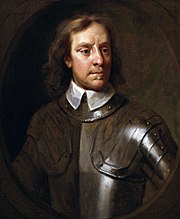
The deaths of John Pym andJohn Hampdenin 1643 removed a unifying force within Parliament, and deepened divisions. Supported by the Scots, the 'Peace Party' were concerned by political radicals like theLevellers,and wanted an immediate, negotiated settlement. The 'War Party' fundamentally mistrusted Charles, and saw military victory as the only way to secure their objectives. Many werereligious Independentswho opposed any state church, and strongly objected to Scottish demands for a unified, Presbyterian church of England and Scotland;Oliver Cromwellclaimed he would fight, rather than accept such an outcome.[55]
Failure to exploit Marston Moor, Essex' capitulation at Lostwithiel, and Manchester's alleged unwillingness to fight at Newbury led to claims some senior commanders were not committed to victory. Accusations against Manchester and Essex in particular were not confined to Cromwell, but shared by some Presbyterians, including Waller.[56]In December,Sir Henry Vaneintroduced theSelf-denying Ordinance,requiring any military officers who also sat in Parliament to resign one office or the other. Manchester and Essex were automatically removed, since they could not resign their titles, although they could be re-appointed, 'if Parliament approved.'[57]
It also led to the creation of theNew Model Army,a centralised, professional force, able and willing to operate wherever needed. Many of its recruits had served with Cromwell in the Eastern Association, or shared his views, and opponents viewed the New Model with suspicion from the outset. To offset this, they appointed the moderates Fairfax andPhilip Skipponas Commander-in-Chief and head of the infantry respectively, as well as retaining some regional forces. These included the Northern and Western Associations, plus those serving inCheshireand South Wales, all commanded by supporters of the Presbyterian faction in Parliament. Although he remained an MP, Cromwell was given command of the cavalry, under a 'temporary' three-month commission, constantly renewed.[58]
1645[edit]
In January, representatives of both sides met atUxbridgeto discusspeace terms,but talks ended without agreement in February. Failure strengthened the pro-war parties, since it was clear Charles would never make concessions voluntarily, while divisions among their opponents encouraged the Royalists to continue fighting.[59]In early 1645, the Royalists still controlled most of the West Country, Wales, and counties along the English border, despite losing their key supply base at Shrewsbury in February.[60]Lord Goring's Western Army made another attempt on Portsmouth and Farnham; although he was forced to retreat, it showed Parliament could not assume this area was secure, whileMontrose's Highland Campaignopened another front in the war.[61]
On 31 May, Prince Rupert stormedLeicester;in response, Fairfax and the New Model Army abandoned their blockade of Oxford, and on 14 June, won a decisive victory atNaseby.[62]Defeat cost the Royalists their most formidable field army, along with their artillery train, stores, and Charles' personal baggage. This included his private correspondence, detailing efforts to gain support from theIrish Catholic Confederation,thePapacyand France. Published by Parliament in a pamphlet entitledThe King's Cabinet Opened,it seriously damaged his reputation.[63]
After Naseby, Royalist strategy was to preserve their positions in Western England and Wales, while their cavalry went north to link up with Montrose in Scotland. Charles also hoped the Irish Catholic Confederation would supply him with an army of 10,000, that would land in Bristol and combine with Lord Goring to smash the New Model. Such hopes were illusory, and the only result was to deepen divisions among the Royalist leadership, many of whom viewed the proposed use of Catholic Irish troops in England with as much horror as their Parliamentarian opponents.[64]Concerned by the wider implications of Royalist defeat and urged on by Henrietta Maria, French chief ministerCardinal Mazarinlooked for ways to restore Charles with minimal French intervention. Talks were held between his representative,Jean de Montereul,andLord Lothian,a senior Covenanter who was deeply suspicious of Cromwell and the Independents, but these discussions ultimately went nowhere.[65]

Prince Rupert was sent to supervise the defence of Bristol and the West, while Charles made his way toRaglan Castle,then headed for the Scottish border. He reached as far north asDoncasterin Yorkshire, before retreating to Oxford in the face of superior Parliamentarian forces. In July, Fairfax lifted thesiege of Taunton;a few days later atLangport,he destroyedLord Goring's Western Army, the last significant Royalist field force.[66]At the end of August, Charles left Oxford to relieveHereford,which wasbesieged by the Covenanter army;as he approached, Leven was ordered to return to Scotland, following Montrose's victory atKilsyth.The king moved onto Chester, where he learned Prince Rupert had surrenderedBristolon 10 September. Shocked by the loss, Charles dismissed his nephew.[67]
While one detachment from the New Model underColonel RainsboroughsecuredBerkeley Castle,another under Cromwell captured Royalist strongholds atBasing Houseand Winchester. Having secured his rear, Fairfax began reducing remaining positions in the west; by now,Clubmenmilitia in Hampshire and Dorset were as big an issue as the Royalist army.[68]When his remaining cavalry were scattered atRowton Heathon 24 September, Charles abandoned attempts to reach Scotland and returned to Newark. On 13 October, he learned of Montrose's defeat atPhiliphaugha month earlier, ending plans for taking the war into Scotland. The loss ofCarmarthenandChepstowin South Wales cut connections with Royalist supporters in Ireland (see Map) and Charles made his way back to Oxford, where he spent the winter besieged by the New Model.[69]
1646[edit]
Following the fall of Hereford in December 1645, the Royalists held only Devon, Cornwall, North Wales, and isolated garrisons in Exeter, Oxford, Newark, andScarborough Castle.Chester surrendered in February, after which the Northern Association Army joined the Covenanters besieging Newark. Hopton replacedLord Goringas commander of the Western Army, and attempted to relieve Exeter. Defeated by the New Model atTorringtonon 16 February, he surrendered atTruroon 12 March.[70]
The last pitched battle of the war took place atStow-on-the-Woldon 21 March, when 3,000 Royalists were dispersed by Parliamentary forces.[71]With the end of the war in sight, Parliament issued a proclamation, allowing favourable terms for any Royalists who 'compounded' prior to 1 May. Those whose estates had been confiscated could regain them on payment of a fine, which was calculated on the value of their lands, and level of support; many took advantage of this.[72]
After capturing Exeter andBarnstaplein April, the New Model marched on Oxford; on 27 April,Charles left the city in disguise, accompanied by two others.Parliament learned of his escape on the 29th, but for over a week had no idea where he was. On 6 May, they received a letter fromDavid Leslie,the Scottish commander at Newark, announcing he had Charles in custody. Newark surrendered the same day, and the Scots went north to Newcastle, taking the king with them. This led to furious objections from Parliament, who approved a resolution ordering the Scots to leave England immediately.[73]
After lengthy negotiations,Oxford capitulatedon 24 June; the garrison received passes to return home, and Prince Rupert and his brother,Prince Maurice,were ordered to leave England.Wallingford Castlesurrendered on 27 July, then the remaining Royalist strongholds, althoughHarlech Castlein Wales held out until 13 March 1647.[74]
Aftermath[edit]
In 1642, many Parliamentarians assumed military defeat would force Charles to agree to terms, which proved a fundamental misunderstanding of his character. When Prince Rupert told him in August 1645 that the war could no longer be won, Charles responded that while this may have been an accurate assessment of the military situation, 'God will not suffer rebels and traitors to prosper'. This deeply-held conviction meant he refused to agree to any substantial concessions, frustrating both allies and opponents.[75]

Although Charles correctly assumed widespread support for the institution of monarchy made his position extremely strong, he failed to appreciate the impact of his constant prevarications, both before and during the war. He made peace with the Scots in 1639, then raised an army against them in 1640, while his actions prior to March 1642 convinced Parliament he would not keep his promises, and that any money they supplied to him would be employed against them. At various points in the period following Royalist defeat in 1646, he was negotiating separately with the Irish Confederation, the English Independents, the Covenanters, English Presbyterians, France, and the Papacy.[76]
The result was the creation of a powerful faction who believed Charles would never voluntarily agree to a suitable political settlement, and whose control of the New Model Army gave them the ability to impose one. Often grouped together as 'Independents', the reality was far more fluid; Sir Thomas Fairfax was a Presbyterian, who fought for Charles in 1639, and refused to participate in his execution, while even Cromwell initially viewed him with great respect.[77]William Fiennes, 1st Viscount Saye and Sele,and his sonsNathanielandJohn,are examples of those supported the Independents out of religious conviction, but wanted Charles to retain his throne.[78]
Charles continued to stall, to the increasing frustration of all parties, especially members of the New Model, many of whom had not been paid for over a year and wanted to go home. By March 1647, these arrears amounted to some £2.5 million, an enormous sum for the period, and moderates in Parliament led by Denzil Holles decided to remove the threat by sending the army to Ireland.[79]Importantly, only those who agreed to go would receive their arrears, and when regimental representatives, orAgitators,demanded full payment for all in advance, Parliament disbanded the New Model, which refused to be dissolved.[80]Although both Cromwell and Fairfax were disturbed by the radicalism displayed by parts of the army in thePutney Debates,they supported them against Parliament over the issue of pay. These tensions contributed to the outbreak of theSecond English Civil Warin 1648.[81]
Notes[edit]
- ^These also include the 1639 and 1640Bishops' Wars,the 1641 to 1653Irish Confederate Wars,the 1648Second English Civil War,the 1650 to 1652Anglo-Scottish War,and 1649 to 1653Cromwellian conquest of Ireland
- ^The equivalent figure for losses incurred during the 1914 to 1918World War Iwas 2.23%
- ^Some historians, such as Trevor Royle, suggest 1638 to 1660
- ^Edmund Verney,killed fighting for Charles atEdgehillin 1642, opposed his religious reforms and voted against him inParliament
References[edit]
- ^abCarlton 1992,p. 204.
- ^Mortlock 2017.
- ^Woolrych 2002,p. 398.
- ^Zuvich 2015,pp. 88–89.
- ^Royle 2006,pp. 806–813.
- ^Worsley 2007,p. 462.
- ^Burch 2003,pp. 228–284.
- ^Harris 2014,pp. 457–458.
- ^Rees 2016,p. 16.
- ^Wedgwood 1958,pp. 26–27.
- ^Macleod 2009,pp. 5–19 passim.
- ^Spurr 1998,p. 10.
- ^Hardacre 1956,p. 10.
- ^Royle 2006,pp. 373–375.
- ^Spurr 1998,pp. 11–12.
- ^Schwarz 2004.
- ^Milton 2021,p. 111.
- ^Helmholz 2003,p. 102.
- ^Wedgwood 1958,p. 31.
- ^Marsh 2020,pp. 79–80.
- ^Rees 2016,pp. 103–105.
- ^Hutton 2003,pp. 155–156.
- ^Hutton 2003,p. 4.
- ^Hutton 2003,pp. 5–6.
- ^"Trained Bands".BCW Project.Retrieved13 March2020.
- ^Hutton 2003,p. 10.
- ^Wedgwood 1958,p. 105.
- ^Purkiss 2006,pp. 249–250.
- ^Wedgwood 1958,p. 74.
- ^Wedgwood 1958,pp. 81–82.
- ^Weston 1960,pp. 428–430.
- ^Malcolm 1977,pp. 254–260.
- ^Hutton 2003,p. 19.
- ^Royle 2006,pp. 184–185.
- ^Royle 2006,pp. 186–187.
- ^Royle 2006,pp. 193–198.
- ^Wedgwood 1958,pp. 152–153.
- ^Royle 2006,pp. 208–209.
- ^Royle 2006,pp. 225, 231.
- ^Day 2007,pp. 2–3.
- ^Johnson 2012,pp. 172–174.
- ^Royle 2006,p. 275.
- ^Wedgwood 1958,p. 281.
- ^Wedgwood 1958,pp. 252–254.
- ^Royle 2006,p. 280.
- ^Kaplan 1970,p. 57.
- ^Robertson 2014,pp. 109–111.
- ^Royle 2006,p. 283.
- ^Wedgwood 1958,p. 308.
- ^Wedgwood 1958,pp. 330–331.
- ^Royle 2006,pp. 289–290.
- ^Royle 2006,pp. 295–299.
- ^Wedgwood 1958,p. 385.
- ^Hutton 2003,pp. 156–158.
- ^Rees 2016,pp. 118–119.
- ^Cotton 1975,p. 212.
- ^Wedgwood 1958,pp. 398–399.
- ^Royle 2006,p. 319.
- ^Wedgwood 1958,p. 404.
- ^Hopper 2012,p. 132.
- ^Montrose Campaign.
- ^Royle 2006,p. 332.
- ^Royle 2006,pp. 333–334.
- ^Scott 2008,p. 51.
- ^Royle 2006,pp. 337–338.
- ^Wedgwood 1958,pp. 465–466.
- ^Royle 2006,p. 357.
- ^Wedgwood 1958,pp. 472–473.
- ^Wedgwood 1958,pp. 504–505.
- ^Wedgwood 1958,pp. 540–541.
- ^Royle 2006,p. 366.
- ^Wedgwood 1958,p. 550.
- ^Royle 2006,p. 393.
- ^Royle 2006,p. 387.
- ^Royle 2006,pp. 354–355.
- ^Wedgwood 1958,pp. 546–548.
- ^Yule 1968,pp. 11–32.
- ^Smith 2004.
- ^Morrill 1972,p. 49.
- ^Royle 2006,pp. 393–394.
- ^Royle 2006,pp. 420–425.
Works cited[edit]
- Burch, Stuart (2003).On Stage at the Theatre of State: The Monuments and Memorials in Parliament Square, London(PDF)(PHD thesis). Nottingham Trent University.Retrieved18 August2022.
- Carlton, Charles (1992).Going to the wars; the experience of the British civil wars 1638 to 1651.Routledge.ISBN0-4150-3282-2.
- Cotton, ANB (1975). "Cromwell and the Self-Denying Ordinance".History.62(205): 211–231.doi:10.1111/j.1468-229X.1977.tb02337.x.JSTOR24411238.
- Day, Jon (2007).Gloucester & Newbury 1643: the Turning Point of the Civil War.Havertown: Pen and Sword.ISBN978-1-4738-1464-6.
- Hardacre, Paul (1956).The Royalists during the Puritan Revolution.Springer.ISBN978-9-4017-4563-5.
- Harris, Tim (2014).Rebellion: Britain's First Stuart Kings, 1567–1642.OUP.ISBN978-0-1992-0900-2.
- Helmholz, R.H. (2003). Mulholland, Maureen (ed.).Judges and trials in the English ecclesiastical courts in "Judicial Tribunals in England and Europe, 1200–1700 Volume I".Manchester University Press.ISBN978-0-7190-6342-8.
- Hopper, Andrew (2012).Turncoats and Renegadoes: Changing Sides During the English Civil Wars.OUP.ISBN978-0-1995-7585-5.
- Hutton, Ronald (2003).The Royalist War Effort 1642–1646.Routledge.ISBN978-0-4153-0540-2.
- Johnson, David (2012).Parliament in crisis; the disintegration of the Parliamentarian war effort during the summer of 1643(PDF)(PHD thesis). York University.
- Kaplan, Lawrence (1970). "Steps to War: The Scots and Parliament, 1642-1643".Journal of British Studies.9(2): 50–70.doi:10.1086/385591.JSTOR175155.S2CID145723008.
- Macleod, Donald(Autumn 2009)."The influence of Calvinism on politics"(PDF).Theology in Scotland.XVI(2).
- Malcolm, Joyce (1977). "A King in Search of Soldiers: Charles I in 1642".The Historical Journal.21(2): 251–273.doi:10.1017/S0018246X00000534.JSTOR2638260.S2CID154575635.
- Marsh, Bethany (2020). "A War of Words; politics, propaganda and censorship during the Civil Wars".History Today.70(B).
- Milton, Anthony (2021).England's Second Reformation; the Battle for the Church of England 1625–1662.CUP.ISBN978-1-1081-6930-1.
- Montrose Campaign."Campaigns of Montrose".BCW Project.Retrieved28 August2020.
- Morrill, John (1972). "Mutiny and discontent in English provincial armies 1645-1647".Past and Present(56): 49–74.doi:10.1093/past/56.1.49.
- Mortlock, Stephen (2017)."Death and Disease in the English Civil War".The Biomedical Scientist.Retrieved16 July2020.
- Purkiss, Diane (2006).The English Civil War: A People's History.Harper Press.ISBN978-0-0071-5061-8.
- Rees, John (2016).The Leveller Revolution.Verso.ISBN978-1-7847-8390-7.
- Robertson, Barry (2014).Royalists at War in Scotland and Ireland, 1638–1650.Ashgate.ISBN978-1-4094-5747-3.
- Royle, Trevor (2006) [2004].Civil War: The Wars of the Three Kingdoms 1638–1660.Abacus.ISBN978-0-3491-1564-1.
- Schwarz, Marc (2004). "Fiennes, Nathaniel (1607/8–1669)".Oxford Dictionary of National Biography(online ed.). Oxford University Press.doi:10.1093/ref:odnb/9413.(Subscription orUK public library membershiprequired.)
- Scott, David (2008). Adamson, John (ed.).Rethinking Royalist Politics, 1642–1647; in The English Civil War: Conflict and Contexts, 1640–49.Palgrave.ISBN978-0-3339-8656-1.
- Smith, David (2004). "William Fiennes, 1st Viscount Saye and Sele (1582–1662)".Oxford Dictionary of National Biography(online ed.). Oxford University Press.doi:10.1093/ref:odnb/9415.(Subscription orUK public library membershiprequired.)
- Spurr, John (1998).English Puritanism, 1603-1689.Palgrave.ISBN978-0-3336-0188-4.
- Wedgwood, C.V. (1958).The King's War, 1641–1647(1983 ed.). Penguin Classics.ISBN978-0-1400-6991-4.
- Weston, Corinne (1960). "English Constitutional Doctrines from the Fifteenth Century to the Seventeenth: II. The Theory of Mixed Monarchy under Charles I and after".English Historical Review.75(296): 426–443.doi:10.1093/ehr/LXXV.296.426.JSTOR557624.
- Woolrych, Austin (2002).Britain in Revolution.OUP.ISBN978-0-1982-0081-9.
- Worsley, Lucy (2007).Cavalier: The Story of a 17th Century Playboy.Faber & Faber.ISBN978-0-5712-2703-7.
- Yule, George (1968). "Independents and Revolutionaries".Journal of British Studies.7(2): 11–32.doi:10.1086/385550.JSTOR175293.S2CID145327855.
- Zuvich, Andrea (2015).The Stuarts in 100 Facts.Amberley Publishing.ISBN978-1-4456-4731-9.
Further reading[edit]
- Evans, D.H. (2018)."The Fortifications of Hull between 1321 and 1864".Archaeological Journal.175(1): 87–156.doi:10.1080/00665983.2017.1368156.
External links[edit]
- "British Civil Wars, 1638 to 1651".National Army Museum.Retrieved22 March2020.
- "Trained Bands".BCW Project.Retrieved13 March2020.

